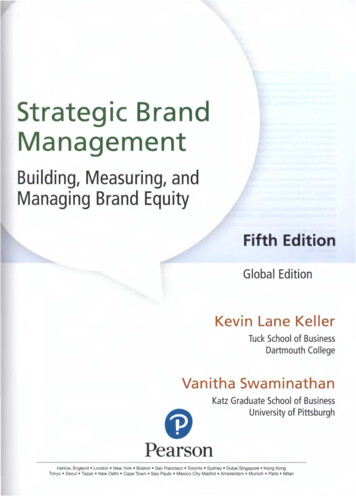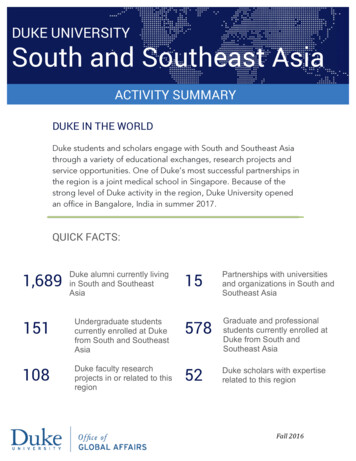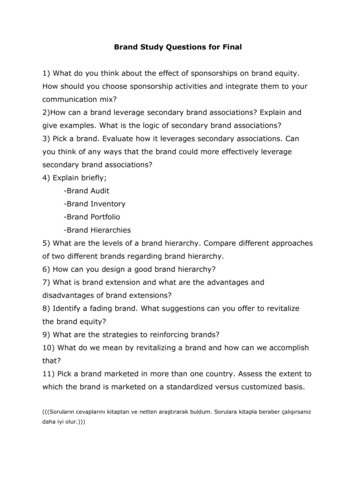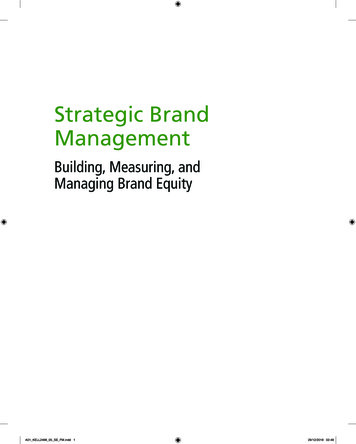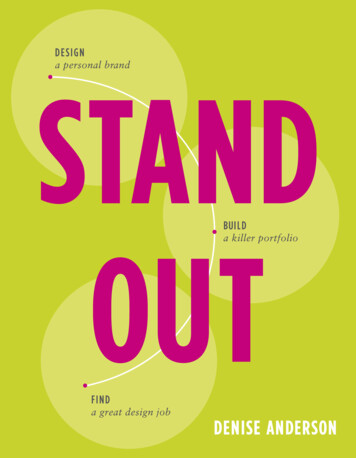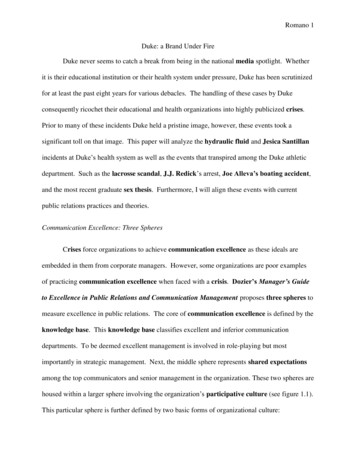
Transcription
Romano 1Duke: a Brand Under FireDuke never seems to catch a break from being in the national media spotlight. Whetherit is their educational institution or their health system under pressure, Duke has been scrutinizedfor at least the past eight years for various debacles. The handling of these cases by Dukeconsequently ricochet their educational and health organizations into highly publicized crises.Prior to many of these incidents Duke held a pristine image, however, these events took asignificant toll on that image. This paper will analyze the hydraulic fluid and Jesica Santillanincidents at Duke’s health system as well as the events that transpired among the Duke athleticdepartment. Such as the lacrosse scandal, J.J. Redick’s arrest, Joe Alleva’s boating accident,and the most recent graduate sex thesis. Furthermore, I will align these events with currentpublic relations practices and theories.Communication Excellence: Three SpheresCrises force organizations to achieve communication excellence as these ideals areembedded in them from corporate managers. However, some organizations are poor examplesof practicing communication excellence when faced with a crisis. Dozier’s Manager’s Guideto Excellence in Public Relations and Communication Management proposes three spheres tomeasure excellence in public relations. The core of communication excellence is defined by theknowledge base. This knowledge base classifies excellent and inferior communicationdepartments. To be deemed excellent management is involved in role-playing but mostimportantly in strategic management. Next, the middle sphere represents shared expectationsamong the top communicators and senior management in the organization. These two spheres arehoused within a larger sphere involving the organization’s participative culture (see figure 1.1).This particular sphere is further defined by two basic forms of organizational culture:
Romano 2participative and authoritarian. Applying these spheres to Duke University’s athleticdepartment and health system will aid in deciding whether or not they achieved communicationexcellence.Looking at the layers of the communication excellence sphere and analyzing thecharacteristics that define each sphere we can see that Duke predominately did not exemplifycommunication excellence with the exception of J.J. Redick’s case. Unlike Duke’s other casesRedick’s agent/communicator displayed communication excellence. He displayedcharacteristics that are common in the three spheres. Starting at the core Redick’s agent, ArnTellem, exhibited characteristics of communicator knowledge including strategic managementand planning, handling media inquiries, deflected potentially damaging news, and facilitatedboth one-way and two-way communication methods. It can be assumed that due to theoutcome of Redick’s case Tellem achieved qualities of the middle sphere by playing thestrategic role of a boundary spanner and environmental scanner. Tellem was able to do thisthrough the shared expectations of his dominant coalition. Due to the successful outcome ofTellem’s efforts in Redick’s case one can assume the Tellem’s organization’s participativeculture which instilled shared values among all employees. The case of former Duke basketballstar J.J. Redick is a good example of a crisis situation where communication excellence wasdisplayed which resulted in a positive crisis outcome.As Duke began to pick up the pieces of their tarnished image from the lacrosse scandalOwen’s sex thesis surfaced four years later, drawing Duke back into a national negative mediaspotlight. Duke graduate, Karen Owen unofficial senior thesis entitled, “An Education Beyondthe Classroom: Excelling in the Realm of Horizontal Academics” became an overnight Internetsensation not to mention a major crisis situation for Duke athletics as well. Unlike Redick’s
Romano 3case this case is seen as being unsuccessful in achieving communication excellence. Redickappointed an agent/communicator for his case, Owen did not. This may have been her firstmistake in preventing her from achieving communication excellence. First, it is apparent thatOwen was not a technician able to handle media inquires, provide materials, and deflectdamaging news. She was not hugely successful in getting her story and statement out to thepublic participating in only one interview and ignoring the rest of the media mainstream.Likewise, Duke University did not have a hold on the situation either failing in communicationexcellence. Duke University also failed in the realm communication excellence by notparticipating in one-way or two-way communication; they also did not forge partnerships withthe dominant coalition. Duke failed miserably in communication excellence regarding thecase of graduate student Karen Owen’s sex thesis.The three spheres of communication excellence serves as a platform to guideorganizations to communicate effectively internally and externally and to build meaningfulrelationships with key publics. We can see in the outcome of J.J. Redick’s DWI crisis thateffectively participating in the three spheres is beneficial to rescue ones reputation andmaintain positive publics. The case of Karen Owen’s sex thesis is a prime example of a failedattempt at communication excellence. Furthermore, not actively participating in the threespheres can lead to damaging effects of ones reputation, which Duke University exemplified inthe sex thesis scandal.Models
Romano 4J. Grunig predicted that there is a relationship among an organization’s environment andstructure to the model(s) of public relations. These four models include press agentry, publicinformation, two-way asymmetric, and two-way symmetric. Successful public relationsscholars are to practice in a two-way symmetrical method of communication with their publics.It is especially vital to react using these models when experiencing a turbulent situation, butmany organizations fail to do so. All of Duke’s cases discussed throughout this paper mainly usethe public information model, which does not seek to persuade publics but rather todisseminate information. This one-way movement of information is best illustrated whenDuke’s lacrosse team, J.D. Alleva, and Jesica Santillan crises occurred as they all madestatements about the occurrences to the public. Although the information may not have beenrelayed in a timely manner they still informed the public of the recent mishaps thereforeparticipating in Gruing’s public information model.TheoriesOther useful typologies for understanding public relations include theories. All ofDuke’s cases serve as a prime example of the major role the media plays in the minds of thepublic. The media is continuously influencing citizens setting the agenda for what we talk andthink about, this is known as the agenda setting theory. Media coverage is an important faucetof a crisis. As mediated reports set the tone and ultimately determine an organization’sreputation as stakeholders receive information. For example, J.J. Redick spoke directly withnumerous media outlets and made a public apology following his arrest saying: "I regret whathappened last night, and want to apologize to my family and the Duke community for theincident." Furthermore, Redick’s former coach Mike Krzyzewski made a statement as wellsaying: “J.J. knows he made a mistake and regrets it," Krzyzewski said. "He represented the very
Romano 5best in college athletics and exhibited outstanding character at Duke the last four years. He is andwill continue to be a credit to the Duke Basketball family. As his friend and his coach, he has mytotal support.” All of the media clippings for this particular case portrayed Redick in a positivelight which consequently did not ruin his reputation. On the other hand, Duke University’sreputation in this case was portrayed by the media in a seemingly negative light. It was badenough Duke had to deal with their lacrosse team’s scandal and not even a year later Duke wascatapulted into the mainstream media for Redick’s arrest. As a result, the media was quick toblame Duke causing them to defend their image.Another theoretical approach to describe the Duke cases is systems theory. Systemstheory is an ecological approach to forming relationships with the public. The main focus ofthis particular theory revolves around the stakeholders of the organization. This theorydistinguishes the participating organizations into two categories: open or closed systems.Nearly all organizations are relatively open or relatively closed in the interchanges with theirenvironment. Indications of insensitivity to environments are a telling characteristic of a closedsystem. These closed boundaries are unhealthy as little information in exchanged between thesystem and its publics. Duke did not act as a closed system in all of these cases but it is evidentthat they did in some.In the 2005 case of the hydraulic elevator fluid Duke University Health Systems reactedin a closed manner to the crisis. When news reports of the incident began to surface Dukeremained silent. Saying nothing to the media gave the impression they were trying to hide thefacts and shift the blame. In a hospital setting where patients’ health is at stake it is vital that theorganization talk openly to the families and patients involved instead of retreating behind a wallof silence. Some patients who underwent surgery at Duke during this time reported health issues
Romano 6from the contaminated instruments. Duke’s hospital officials dismissed the symptoms eventhough the hospital urged them to report any indications of infection. Although Duke sent lettersto potentially exposed patients it wasn’t until the following year. Thomas Henderson, a Raleighlawyer helping the victims of the fluid mix-up, commented on Duke’s closed system stating:“What we really want is a response from Duke to prove their assertions that there was very littlerisk to the patients I mean, patients are hanging out there with problems and Duke won't givean answer to us." From a patient’s perspective, Larry Preston says of Duke: “They haven't beenforthcoming to anybody about anything that they knew about prior to or that they know now.Anything that has been exposed as far as knowledge of this situation has been pried out of them.”Thus, we can see from an example of the Duke hydraulic fluid mix-up that acting as a closedsystem is not an effective means in communicating with publics and tarnished the healthsystems reputation.An open system on the other hand interacts with its environment creating the likelihoodto survive and prosper in the public’s eyes. Although Duke’s health system did not succeed inbeing an open system Duke’s President Brodhead fostered an open system after the Dukelacrosse scandal. Following the event Duke held press conferences, issued press releases anddirected the public to their website which expressed its perspective on the allegations. PresidentRichard Brodhead also made an appearance on the highly credible CBS 60 Minutes. In addition,Brodhead issued numerous letters to various stakeholders regarding the closing of the case andfuture directions to build a stronger community. Although Brodhead was criticized for his delayin responding to the events he continued to be a consistent voice throughout the scandal.The social exchange theory asserts that people strive to minimize costs and maximizerewards. Rewards can be defined as something that is satisfying. Rewards don’t necessarily
Romano 7have to be material or economic they can also be symbolic such as attention or status. Thistheory can be applied to Karen Owen’s sex thesis which began as a hoax amongst three of herfriends that got into the wrong hands and went viral immediately. Although Karen intended thePowerPoint presentation for her friends she sent it to feel a sense of accomplishment and hopedfor a reward of attention or to obtain a certain rewarding status among her friends. It may seemobvious that Owen analyzed the rewards of her actions but did she assess the costs? Apparentlyshe did not because the costs outweighed Karen’s rewards. Not only did the costs of Karen’ssex thesis tarnish her own reputation but it reflected negatively upon Duke University as well.Owens sex thesis surfacing four year after Duke’s lacrosse scandal only served to revitalize thepublic’s perceptions of Duke as a weak educational institution. Owens thesis reinforced thestereotypes Duke’s lacrosse case previously established about the seemingly casual sexualpractices of Duke students.We can also examine the interactions among Duke and its publics using game theory.We’ve learned that a crucial decision in the duel is not how to act, but when to act. The duel isa situation in which an organization decides to withhold information from the public with thehopes of getting it under control before word spreads. We’ve also seen cases when organizationsbenefit from strategic silence such as the Chernobyl accident. In other instances such asDuke’s hydraulic fluid mix-up and Jesica Santillan’s transplant openness would have beenthe best response. There are varying differences between playing the duel game andstonewalling and it is important to differentiate between the two to foster accurate mediacoverage and positive publics.Publics
Romano 8An aspect of an effective crisis management plan involves distinguishing variouspublics. These publics can be divided into three categories: latent publics, aware publics, andactive publics. Active publics are those that detect a problem or issue in the organization,communicate about it, and organize to do something about it. Latent publics are audiencesaffected by the consequences of the organizations actions. Aware publics are just that, thesepublics have recognized a problem but have not organized or communicated to do anythingabout it. Many publics involved in the Duke lacrosse case obtained high levels of involvementand pr
The case of Karen Owen’s sex thesis is a prime example of a failed attempt at communication excellence. Furthermore, not actively participating in the three spheres can lead to damaging effects of ones reputation, which Duke University exemplified in the sex thesis scandal. Models . Romano 4 J. Grunig predicted that there is a relationship among an organization’s environment and structure .
